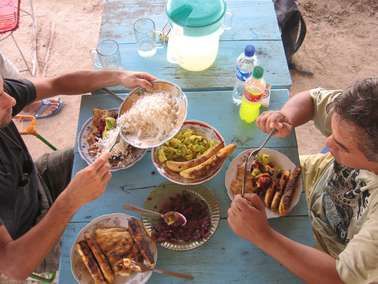
Is the variation in behavior a result of the environments that we have inhabited or the effect of cultural history and traditions that may have persisted over millennia?
At stake is understanding whether human uniqueness is driven by our large brains and intelligence, allowing us to adapt to different environments, or by our unprecedented reliance on social learning or culture.
In research published in the Proceedings of the Royal Society of London B, ASU researchers Sarah Mathew and Charles Perreault find that the main determinant of human behavior is social learning, which is contrary to established assumptions of current thinking in cognitive sciences, psychology and human behavioral ecology.
"Because humans are an unusually smart species, it is tempting to think that individuals figure out on their own the stuff they need to live in different environments," Mathew said. "But we show that humans do much of what they do because it's how their parent generation did it."
Mathew and Perreault are assistant professors in the School of Human Evolution and Social Change in the College of Liberal Arts and Sciences and are both affiliated scientists with the Institute of Human Origins.
While previous studies have alluded to the importance of cultural transmission, their study marks the first time that ecological variation and cultural history have been directly compared with a large sample of societies and behaviors including subsistence, technology, economic organization, settlement patterns, marriage and family, kinship systems and ceremonies and rituals.
Using one of the most comprehensive ethnographic records - the Western North American Indian Dataset - Mathew and Perreault used statistical analysis to compare the relative effect of environment and cultural history.
The ethnographic data is unique because it contains information on 172 Native American tribes geographically spread from Canada to the southern areas of the U.S. West. Mathew and Perreault tested whether the behavioral variation among tribes was due to the fact that they lived in varying environments - from high mountains to coastal regions to deserts - or because they inherited different traditions from their ancestors.
"Our analysis shows, strikingly, that behaviors can persist in cultural lineages for millennia," Perreault said. "In other words, the behavior of a certain tribe, whether in constructing baskets or following certain marriage practices, is largely due to the fact that their ancestors hundreds or even thousands of years ago practiced the behavior. This means that there is considerable cultural inertia in human behavior, which may have persisted for up to 15,000 years."
Cultural inertia is not necessarily disadvantageous, the research noted. Learning from one's parent's generation could be beneficial because it allows for the accumulation of information through time. This capacity for cultural learning may be why modern humans were able to thrive in virtually every terrestrial habitat on Earth and why human societies vary to an extent unmatched in the animal world.



Allowing "for the accumulation of information through time" doesn't mean the data is put to use. NSA's "MetaData" program is infamous for this total waste of time, but at least it keeps some of the psychos busy, right?